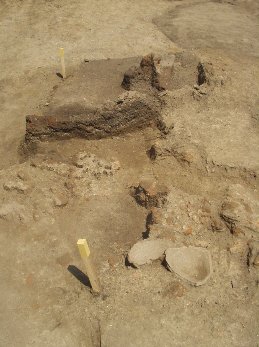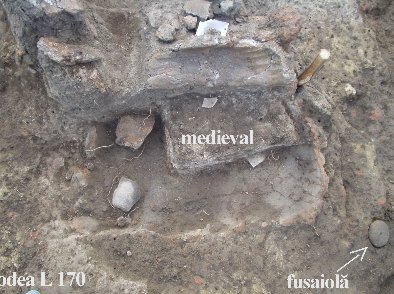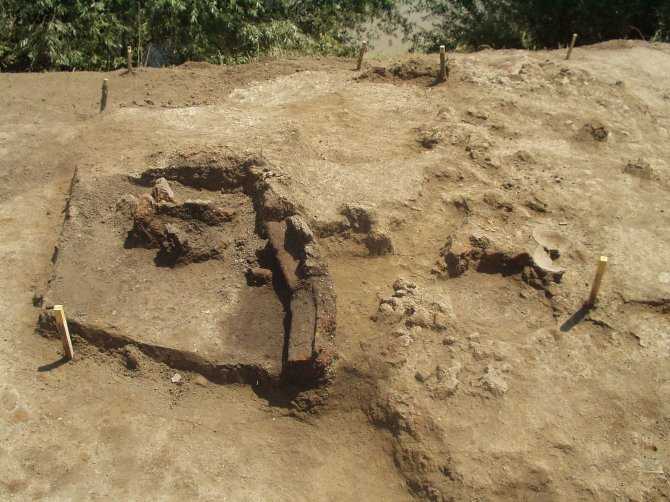

In this level
we have investigated only partially a house with suspended floor,
on an area of 60 cm long and over 2 m width; among the ruins, we
find Tiszapolgár sherds. The house will be entirely investigated
next year.
Neolithic habitation, level 5, Banat IIC culture In the area of the squares 174-182 C have been noticed complexes from the level 5, P 150 and P 115. The treasure hunters that dig in the border of the river, looking for archaeological objects, destroyed House 150. In this way even the upper part of the house of the deer, „Casa Cerbului”, was partially affected.
From this house there are only traces of the floor as well as some sherds, the bigger part of it being destroyed by a Middle Agee pit house (P170/2). The floor was made of bitten clay, after a leveling of the older ruins. From P 150 = 170.2 only a corner of the floor was preserved, as it is possible to see in the lower figure. As mentioned before, from the Middle Agee pit house some sherds and a spindle whorl were preserved. During our investigation, the floor of the Neolithic house was discovered at the level of the pit house filling, so that in the beginning we believed they both belong to the same complex. After we have dismantled the Middle Age oven, it was possible to observe it had been dig in the floor of the house from the level 5 and in the strata of room D, from the level 6. The edges of the house have not been exactly defined, but the floor was over 2.50 m long. So, judging by the old excavations, we believe that this complex was 3.6 – 4 m long (the floor in section 11, being so well define). Because of the different soil subsides in the southern room D of the „Casa Cerbului”, it is impossible to establish its exact contour; the same situation is found in the northern edge, where the area was destroyed by a Middle Age pit house and a pit made by treasure hunters. In the SW part of the margin, we have discovered sherds from the base of a storing pot (fig. 14), a flint blade and an obsidian sliver, as well as sherds on the floor, some of them coming from the upper level, late Neolithic period. We have discovered few sherds, generally spread by the Middle Age habitation; some Neolithic materials (sherds, flint slivers) were found in the filling of the Middle Age pit house.
On the floor, in situ a round clay spindle whorl was discovered (3, 5-4 cm thick), with a small hole maybe used for the lengthening of the fibers of the loom. Such clay instruments have been discovered at Balta Sărăta, where after 6 conic spindle whorls a round follows (Gh. Lazarovici – Sorin Petrescu et alii 2003, p. 163). Under the clay of the floor are the ruins of room D; in this area we have not found any traces of postholes from the structure of the house, even after carefully working with the vacuum cleaner. If these postholes pits have been excavated in the adobes and after filled with the same material, such things are very hard to be detected. The Middle Age postholes pits have been filled with a different material, quite easy to identify. Near the stick of the eastern edge of the floor we found such a pit, maybe Neolithic, maybe Middle Age. The complex was NE-SW oriented; about 3 m long; in the corner were many sherds from a storing pot (fig. 14, 16). This house has the same orientation as that belonging to level 5, but it was longer than the ones in its proximity. Unfortunately, because of an error of the editor, this plan is missing in the Parţa monograph; its place was between p. 170-171 (Lazarovici et alii 2001), (fig. 13). The house is on the same line as the southern houses but bigger than them.
Neolithic habitation, level 6 Level 6 belongs to Banat culture IIB. The radiocarbon data for the houses in the neighborhood of sanctuary II, part of the complex of houses L17/40-L43 (also destroyed in 6 level), are between 5200 – 5000 CAL B.C., earlier as those belonging to the Vinča C phase (Gh. Lazarovici et alii 2001; 2005). We believe that the new radiocarbon data confirm the relative and absolute chronological frame (Mantu 2000; Schier – Draşovean 2004; Lazarovici Gh. 2005; etc.). |



